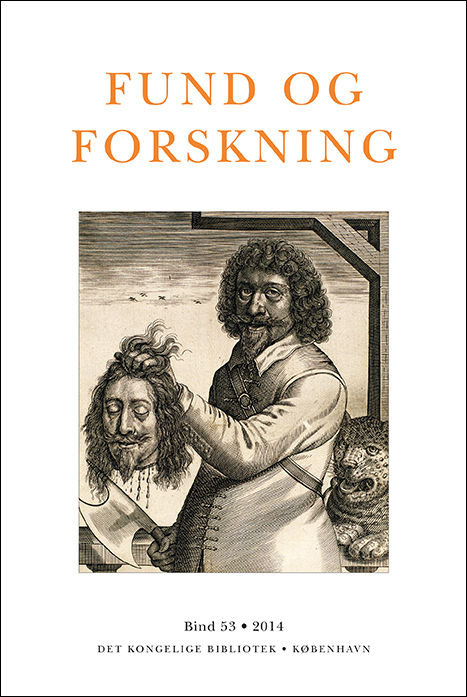Kongemordet i 1286
DOI:
https://doi.org/10.7146/fof.v53i0.118816Resumé
Thomas Riis: The murder of King Erik V
In November 1286 King Erik V of Denmark was murdered, but still today the murderer remains unknown. In literature the marshal Stig Andersen is the person who is most frequently mentioned as the possible murderer; with nine more he was accused and convicted for the murder. Historians agree that the trial was unfair, but no consensus has been found as to the identity of the murderer. In literature Stig wanted revenge, because the king had seduced his wife, but this explication has not been borne out by the sources. A murder for political reasons cannot be excluded, for this reason the article tries for the first time to reconstruct the political groupings during the reign of Erik V. As most royal charters mention a number of witnesses to the act and to the setting up of the charter, we can see which persons belong to the king’s entourage.
Moreover, the systematic study of Eric V’s charters allows us to distinguish phases of his reign characterized by certain policies. Perhaps because of the conflict between king and archbishop in the 1250s, his father Christopher I had fairly often convoked the parliament, and when in 1266 Erik came of age, he continued this practice, at least for some years. His mother Margaret, who had been one of Denmark’s leaders during Erik’s minority, was made Lady of Estonia, which meant that she continued to play a political role. Like her late husband Christopher I, she wanted to continue the strong central government of Valdemar II (1202–1241), thus in the 1270s the parliament was convoked only in 1276. In order to invite its members to recognize the king’s two year old son Erik as heir apparent, the government proposed a statute with rules for the relations between the feudal lords (king, bishops, secular magnates) and their vassals, but it fell in parliament. Further, the marshal Stig refused to recognize the little prince as future king, because his father was still alive. Stig had to leave the government for some years, and with the new seneschal Peder Nielsen Hoseøl from 1279 the partisans of a strong government strengthened their hold on political affairs.
Some years later opposition appeared to have grown, and in 1281, Stig Andersen was back in his former office as marshal. This was not enough to satisfy the opposition; in 1282, the Queen Mother left the government and statutes were voted, which laid down the rules for future political collaboration. Parliament should be convoked once a year, and a habeas corpus clause was introduced.
The question of public finance forms a trend in Danish politics since the middle of the thirteenth century. Ecclesiastical exemptions from royal taxes and other duties had become so extensive that from a government point of view they had become a political problem. To this came further two questions, which Erik V’s government had inherited from its predecessors. Valdemar II had provided for his younger sons by the creation of fiefs: the duchies of Schleswig and of Blekinge, the county of North Halland. Legally, the feudal lord was not obliged to give the fief to the vassal’s heir, but obviously, the descendants wanted to take over their father’s or grandfather’s fief. In the end, it was a question whether or not the government was strong enough to withdraw the fiefs.
A further problem was the inheritance of Erik V’s cousins, the four daughters of his uncle Erik IV (1241–1250). It was obvious that the four princesses had a right to the inheritance after their father, but the government tried to prevent or at least to limit the payment of their inheritance as far as possible. In this it had been successful in the 1260s and 1270s; probably the proposed (but fallen) statute of 1276, Stig Andersen’s reappointment as marshal in 1281, the elimination of the Queen Mother from government, the statutes of 1282 should all be seen as attempts to accommodate the opposition without yielding in the important questions of the fiefs and the princesses’ inheritance. Seneschal Peder’s government also gave a limited political influence to the heirs of some of the vassals. Its restrictive policy could not be maintained, a new government was formed that was to lead a policy of fulfilment; in 1283–1284 the descendants of the vassals were infeft with the duchies of Schleswig and South Halland (in stead of Blekinge) and the county of North Halland. In 1284 a jury recognized the four princesses’ right to their paternal inheritance.
On the whole, the years between 1283 and 1286 were characterized by the cooperation between the king, the government and the parliament, but in November 1286 the king was murdered.
A new government was formed under the former seneschal Peder; in it none of the leading members of the previous government had a seat. With nine others Stig Andersen was accused and convicted as murderers of Erik V.
The alleged murderers appear to have supported the previous government and for this reason it is very unlikely that they should have killed the king with whom they had led the policy of fulfilment. For its opponents this must have been considered a most dangerous sale of the state’s interests; could the king be removed, a minority government would have to be formed and with the right persons in office one could return to the policy led before 1282. Consequently the motif of the murder was the abandonment of the fulfilment policy and the return to the restrictive policy. Its protagonist was the seneschal Peder Nielsen Hoseøl; probably, then, he was the instigator of Erik V’s murder.


